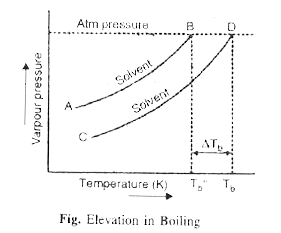Define boiling point and find out expression for the molecular mass of non-volatile solute from the elevation in boiling point.
Elevation in boiling point. The boiling point of a liquid is that temperature at which its vapour pressure becomes equal to the atmospheric pressure. The vapour pressure of a solution is lower than that of a pure solvent. This means that the solution has to be heated to a higher temperature, so that its vapour pressure becomes equal to atmospheric pressure. Therefore, the boiling point of a solvent rises on the addition of a nonvolatile solute and this is called elevation in boiling point.

The elevation in boiling point on the addition of a non-volatile solute to a solvent is shown in Fig. The curve AB represents vapour pressure of the solvent and curve CD represents the vapour pressure of the solution. It can be seen from the figure that at point B on the curve AB, the vapour pressure of the solvent corresponds to atmospheric pressure, hence it corresponds to the boiling point (T0b) of the pure solvent. At point D, the vapour of the solution becomes equal to atmospheric pressure and hence it corresponds to the boiling point (Tb) of the solution. The difference Tb−T2b=ΔTb is called elevation in boiling point, because Tb is greater than ΔT∘b.
Elevation in boiling point, ΔTb=Tb−T∘b.
It has been found out experimentally that the elevation in the boiling point (ΔTb) of a solution is proportional to the molal concentration of the solution i.e.
ΔTb∝morΔTb=Kbm,
where K is called molal elevation constant. This is defined as:
ΔTb=Kb×m
ΔTb=Kb×Wb×1000WA×ΔTb
orMB=Kb×wB×1000wA×ΔTb
∴ knowing alll other factors , MB can be calculated.
Related Playlists
- BOOK - MBD -HARYANA BOARDCHAPTER - SOLUTIONSEXERCISE - SATQ (SHORT ANSWERS TYPE QUESTIONS )16videos
SOLUTIONS
- BOOK - MBD -HARYANA BOARDCHAPTER - SOLID STATEEXERCISE - LONG ANSWER TYPE QUESTIONS10videos
SOLID STATE
- BOOK - MBD -HARYANA BOARDCHAPTER - SURFACE CHEMISTRYEXERCISE - LONG ANSWER TYPE QUESTIONS4videos
SURFACE CHEMISTRY
Similar Questions
Correct expression for elevation in boiling point is :
View SolutionFor a dilute solution containing a nonvolatile solute, the molar mass of solute evaluated from the elevation of boiling point is given by the experssion:
View SolutionFor a dilute solution containing a nonvolatile solute, the molar mass of solute evaluated from the elevation of boiling point is given by the experssion:
View SolutionDerive the expression for molar mass of solute in terms of boiling point elevation of solvent.
View SolutionIllustrate elevation in boiling point with the help of vapour pressure-temperature curve of a solution. Show that elevation in boiling point is a colligative property.
View SolutionStatement-1 : When metyl alcohol is added to water, boliling point of water increases.
Statement-2 : When a volatile solute is added to a volatile solvent elevation in boiling point is observed.View SolutionAssertion (A) When methyl alcohol is added to water, boiling point of water increases.
Reason (R ) When a volatile solute is added to a volatile solvent evevation in boiling point is observed.View SolutionWhich solution will show maximum elevation in boiling point?
View SolutionWhich solution will show maximum elevation in boiling point?
View SolutionThe determination of molar mass from elevation in boiling point is called as……..
View Solution

